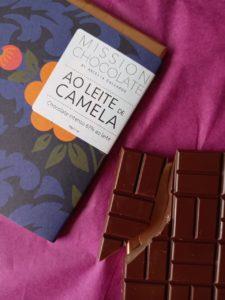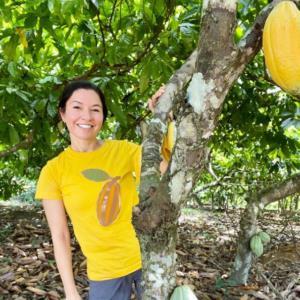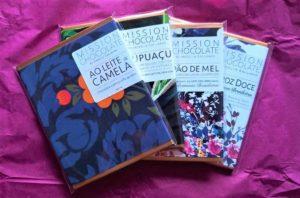(MENAFN- Brazil-Arab News Agency (ANBA))
São Paulo – This month, the Mission Chocolate brand launched a limited-edition camel milk chocolate bar. In just three weeks of sale, the brand's founder, Arcelia Gallardo, needed to produce more to secure stock for a few more days.“We made another 'batch' to be able to serve customers. It was very well received and, if we have high demand, we can scale it to a larger edition,” said the chocolatière.
The bar is on sale at the brand's online store, which ships to Brazil and other countries. The launch is part of the 'Faces of Brasil' ['Rostos do Brasil'] project. The chocolate specialist aims to create a bar for each of the communities composing Brazil. Camel milk chocolate represents the Arabs, especially Syrians and Lebanese, who make up Brazilian culture, especially since the immigration in the 19th and 20th centuries. This was the project's first launch; it will also have products with ingredients to pay tribute to African, native, and Japanese people, among others.“This product line will help to inform abroad what the faces of Brazil are,” said Gallardo, who is North American and has clients in Europe and the United States.

The chocolate bar made with camel milk from Dubai has 61% Brazilian cocoa
Camel milk brings a creamier texture to the chocolate.“For me, it is like a milk much more 'straight from the farm,' I feel a lot of freshness in the bar,” explains the specialist. For the recipe, she needed to import powdered camel milk from Dubai.“We had to buy from abroad, but I am looking for someone in Brazil to supply this milk; I know there must be this person. And it would be great to keep producing it,” she said.
The search for national ingredients is one of the pillars of the brand. All Mission cocoa suppliers are Brazilian, mainly from the states of Bahia and Pará.
This was one of the reasons why the specialist, born in Los Angeles, US, has been based in Brazil for seven years.“We moved here with the idea of exploring the cocoa world because Brazil is the only country in the world that produces a lot but consumes everything it produces. It is even necessary to import cocoa because Brazilians like it a lot, and it has created a solid market,” reveals the specialist, who has in the bean-to-bar movement one of the pillars of her brand — the bean-to-bar advocates buying cocoa directly from producers, without intermediaries.
Beyond the hazelnut
Coming to Brazil, where the brand has a factory, allowed the founder to work closely with cocoa production and find the public for her delicacies in the country.“I wanted to make chocolate with a story, and not just another hazelnut bar, because the whole world already does it. In Brazil, there are so many nuts and fruits, it would not be nice to use hazelnuts if Brazilians had not even tasted what is here,” reveals Gallardo.

The chocolatière constantly visits cocoa farms in Brazil and around the world
Hence, she dedicated herself to the mission of creating entirely new products. And preferably with native ingredients.“I started with the 'Brazilian Biomes' line. Chocolates with umbu and baru were some of the first, and I thought the combination was wonderful. All harvested in family farms, on wild and organically grown plants. I thought: my God, this has a much cooler story than a hazelnut,” she said about the editions of chocolates with fruits from the Caatinga and Brazilian nuts, respectively.
Creating a recipe can take up to a year, from choosing ingredients and tasting to the final production.“Today, there are producers in Brazil who manage to separate cocoa lots, and, with that, I can order cocoa with high acidity, or just sweetness, and choose between different varieties,” revealed Gallardo on the evolution of the Brazilian cocoa production chain, which has gained momentum in the last five years.

The brand has several options of chocolate bars, in addition to selling cocoa husk for infusions
Another creation of the entrepreneur was chocolates with Brazilian desserts. Among the delicacies were papaya cream, rice pudding, honey bread, dulce de leche, and peanut paçoca.“I thought it was wonderful to convert these flavors into a bar, ship it abroad, and Americans and Europeans ask me, 'What is rapadura? What is paçoca?'” she contemplates.
The specialist also travels the world learning and teaching about chocolate. Among the 23 countries she visited, it was in Morocco she came into contact with camel farming. In the native communities she visited, the American taught recipes to add value to the local women's products, still maintaining the local tools and traditions.
Gallardo explains the chocolate itself was first produced in Mexico, despite the plant being of Amazonian origin.“Maybe because the indigenous people further south had already discovered guaraná and mate. And for the people of Mexico, chocolate was the first [energetic] stimulant. So, while they created chocolate there, people from the Amazon produce more cocoa-based beverages. There are many recipes, and each family has its method of making them. It is a lot of learning, and I want to make [this exchange] in all the countries I can,” says the specialist.
Quick facts:
Camel milk chocolate 61% | DARK CAMEL 60G
BRL 30.00
Where to buy:
Translated by Elúsio Brasileiro
The post Camel milk chocolate launched in Brazil appeared first on Agência de Notícias Brasil-Árabe .
MENAFN31082021000213011057ID1102720349
Legal Disclaimer:
MENAFN provides the information “as is” without warranty of any kind. We do not accept any responsibility or liability for the accuracy, content, images, videos, licenses, completeness, legality, or reliability of the information contained in this article. If you have any complaints or copyright issues related to this article, kindly contact the provider above.